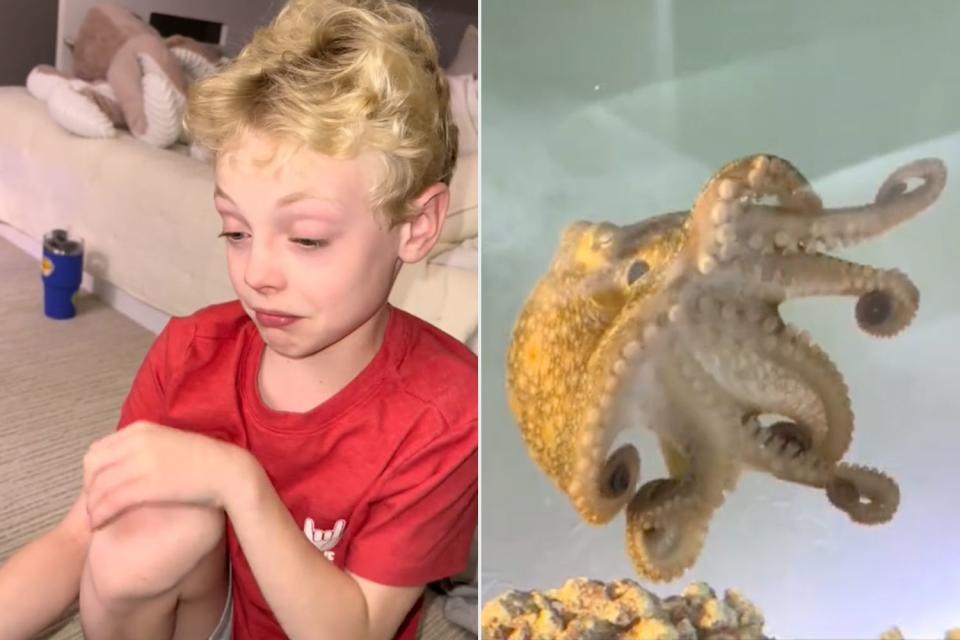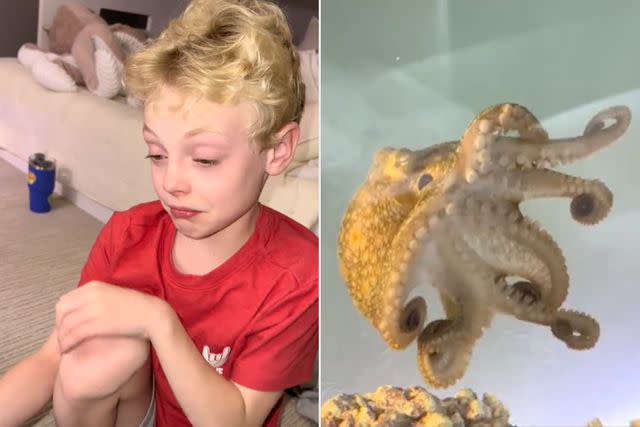Dad Fulfills 9-Year-Old Son's Dream of Having a Pet Octopus. Weeks Later, She Lays Over 40 Eggs (Exclusive)
Cameron had no idea what he was in for when 9-year-old Cal began his campaign for a pet octopus

Cameron Clifford/TikTok
Cal crying over transporting octopi (L), Terrance the Octopus (R)When a dad found an opportunity to make one of his son's biggest dreams come true, he couldn't pass it up.
Since he was "about 2 or 3 years old," Cameron's son Cal had dreams of owning an octopus.
"He's always been infatuated with marine biology, especially octopus. For most birthdays and holidays, he would ask for a pet octopus," the proud dad tells PEOPLE exclusively.
"We always laughed it off. We'd replace it with a stuffed octopus or a toy octopus, but as time went on, he persisted — over many years. We realized this wasn't something he was just going to forget."
Earlier this year, Cameron contacted a local pet store to inquire about how feasible it would be to buy an octopus.
"They told me it's not common. You have to make sure that it's done right and that you're responsible about it, but theoretically, it can be done. So I got to work and did a lot of research, found some reputable websites, some experts and the rest is kind of history."
Never miss a story — sign up for PEOPLE's free daily newsletter to stay up-to-date on the best of what PEOPLE has to offer, from juicy celebrity news to compelling human interest stories.

Cameron Clifford/TikTok
Cal crying over transporting octopi (L), Terrance the Octopus (R)Related: The World’s Oldest Aquarium Fish Is Older Than Scientists Originally Thought, New Study Finds
It was far from easy setting up a hospitable environment for an octopus, especially in Oklahoma, where the family resides.
"The habitats required for these species aren't just your run-of-the-mill saltwater tanks. It requires some additional components that ensure that it's a safe, suitable environment for the octopus," Cameron says.
He continues, "That alone takes a really long time, both to cycle the tank as well as acquire the equipment. You have to read up on how to take care of them and find a suitable food source. You have to ensure that they are constantly stimulated and have all of the things necessary in order to have a safe habitat. That took us quite a while — about two months or preparation to be able to receive an octopus. So it was a lot of work, but certainly well worth it."
Once they were ready, Cameron and Cal bought the two-spot (also known as bimac) octopus, which the 9-year-old named Terrance, home. For the first two months, the two were going through the ropes of learning everything it takes to keep Terrance happy and healthy. Then, they were taken by surprise when the octopus started acting unusual.
"Terrance was very interactive and loved to be visible, with us and involved in the action. So for her to hide out in a cave for a few days straight was extremely unusual," says Cameron.
Cameron started contacting their expert resources, noting, "You can't just take an octopus to the local vet." They learned that Terrance was actually female and that she had laid eggs.
"It was pretty disheartening because we were under the assumption these eggs could not have been fertilized. After speaking to others who knew more about it, we came to the conclusion that these weren't viable eggs and that we would have several weeks after the eggs were laid until we'd lose her."
But Terrance wasn't done with her surprises just yet. It turned out that Terrance's eggs were fertilized after all, something that came as "a complete shock" to the family.
"We were not prepared to take care of so many babies, but at the same time, we were extremely surprised. It's a rarity, I would say extremely rare in Oklahoma, to breed an octopus. I've come to find out it's been done in other places, but it's pretty rare to do so domestically."
In total, Terrance laid "between 40 and 60 eggs," with Cameron sharing, "At one point, we had 50 babies in their tiny, little containers that we had actually kept alive for a week. So, at one point, we were feeding 50 babies at once."
It's been 60 days since Terrance's babies began to hatch. Not only is she continuing to do well, but so are a good number of her little ones.
"We've been able to keep half of them alive," Cameron explains.
"It's extremely difficult to keep them alive. The literature states that if you can get about a 5% yield of babies from the hatched eggs, and that's in favorable conditions. We initially managed to keep about 50 of the babies alive. We lost quite a few in the first few weeks, a lot of which had to do with transporting them and feeding them. Now, at 60 days after hatching, we still have about half that are still with us, which is a pretty hallmark time."
Terrance's babies will remain with Cameron and Cal until they're ready to move on to more appropriate homes.
"Our plan is to re-home them to professional and suitable homes, to get them to people who can obviously take care of them. We have had great traction with bigger aquariums and research institutions. Some universities have expressed interest in them. And we've actually had a few that committed to taking them. The issue is, for now, they're just too small to be moved anywhere."
This first pet experience is far from what Cameron or Cal ever imagined, but it's been an unforgettable and meaningful experience for the father and son pair to share.
"He has been actually infatuated with these since he was a young age and it's one of his dreams in life to be able to have one close up and to be able to experience it right in front of him," Cameron says.
"Obviously, we've ridden the emotions of tears of happiness and knowing that there's a possibility to tears of sadness, knowing that it would die — and all the above, when the baby's hatched. It has been quite an experience to see those emotions in my son, for something that he cares so much about. It's been cool to get a front-row seat to see some of his dreams come to fruition."
Cameron and Cal are unsure if they'll keep any of the babies, noting that "home care is extremely difficult—expensive, time-consuming."
"We're totally prepared to do so, if we need to. However, if we can get them to these organizations where others can also enjoy and appreciate them and learn about and from them, we have a resolve to do so. Protecting this species is our ultimate goal."
Along for the ride have been their nearly 400,000 TikTok followers, who have been learning about Terrance.
"It's been able to connect us to some really amazing people and learn a lot and connect in a way that allows us to get further reach to institutions and places that can better take care of them. I would never have thought opening a TikTok account a month ago would now lead me to some of the things that we're doing and the people we're talking to, but as long as it gets these babies the proper care, I think that that was absolutely worth it."
Cameron and Cal hope people are learning from their experiences with Terrance and "really consider it before doing anything similar."
"They're amazing creatures and animals and should be treated as such. We hope that this will get us in contact with the right people so that we can further protect, appreciate and respect this species."
For more People news, make sure to sign up for our newsletter!
Read the original article on People.

